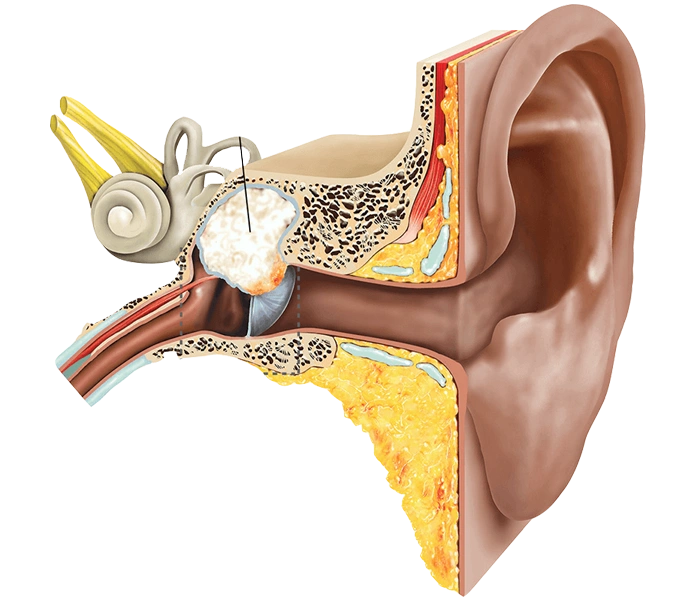Ear Tumors: Diagnosis, Treatment, and the Importance of Prompt Care
Presented by: cckaam
Ear tumors are considered a serious concern in the field of otology and audiology, with potentially significant impacts on a patient’s quality of life. These tumors may be benign or malignant, and treatment approaches vary based on their type and location. This article explores the nature of ear tumors, their symptoms, diagnostic procedures, and treatment options—highlighting the critical importance of timely and accurate medical intervention.
What Are Ear Tumors?
Ear tumors refer to abnormal cell growths in various parts of the ear, which may occur in either the inner or outer ear. These tumors can be benign (non-cancerous) or malignant (cancerous) and are among the common causes of hearing loss and ear pain. Ear tumors can affect individuals of all ages, placing every age group at potential risk.
Types of Ear Tumors
- Benign Tumors
- Cholesteatoma: A non-cancerous growth usually occurring in the middle ear, capable of damaging surrounding structures. Symptoms may include hearing loss, ear discharge, and ear pain.
- Vestibular or Auditory Nerve Neoplasms: These benign tumors develop on the auditory (hearing) or vestibular (balance) nerves and may lead to dizziness and hearing impairment.
- Malignant Tumors
- Squamous Cell Carcinoma: A cancerous tumor that can grow in various parts of the ear and is often associated with pain, bleeding, and visible changes in the ear’s appearance.
- Neurological Tumors: Some tumors may arise from brain tissue or nerves near the ear, potentially causing severe pain, hearing loss, and dizziness.
Symptoms of Ear Tumors
Symptoms vary depending on the type and location of the tumor, but common signs include:
- Hearing Loss: The most common symptom, particularly in benign tumors.
- Ear Pain: Persistent or acute pain in the ear may signal the presence of a tumor.
- Ear Discharge: Continuous ear discharge—especially with a foul odor—can indicate a tumor.
- Dizziness or Imbalance: Tumors can interfere with balance, causing vertigo.
- Visible Changes in the Ear: Swelling or enlargement may suggest a tumor’s presence.
Diagnosing Ear Tumors
Accurate diagnosis typically involves a combination of clinical examination and advanced imaging techniques, such as:
- Physical Ear Examination: An ENT specialist conducts a thorough visual and manual assessment of the ear and surrounding areas.
- Magnetic Resonance Imaging (MRI): Used to precisely locate and measure tumors, particularly those deep within the ear.
- Computed Tomography (CT Scan): Helps detect structural abnormalities in various parts of the ear.
- Audiometric Testing: Evaluates the extent of hearing loss and the tumor’s impact on auditory function.
Treatment of Ear Tumors
Treatment varies according to tumor type and location and typically involves surgery, radiation therapy, and sometimes medication.
- Surgical Treatment
- For Benign Tumors: Surgical removal of the tumor is standard and may range from simple to complex procedures, depending on the tumor’s size and type (e.g., cholesteatoma, vestibular neoplasms).
- For Malignant Tumors: These usually require more extensive surgery, potentially involving the removal of cancerous tissues along with detailed diagnostic evaluation.
- Radiation Therapy
Used primarily for malignant tumors or when surgery is not feasible. Radiation can help shrink the tumor or destroy cancerous cells.
- Pharmacological Therapy
In some cases, medications may be prescribed to reduce tumor size or inhibit its growth. This is usually applied alongside other treatments in early-stage cases.
The Importance of Timely Treatment
Prompt treatment of ear tumors is vital. Delayed diagnosis and therapy can result in severe complications, including permanent hearing loss, nerve damage, and the potential spread of malignancy to other parts of the body. Early detection and proper management significantly improve outcomes and help preserve the patient’s quality of life.
Conclusion
Ear tumors can lead to serious hearing and quality-of-life challenges. Early diagnosis and timely intervention are essential. With advanced treatments—including surgery, radiotherapy, and medication—effective management is achievable, allowing patients to recover and return to normal life. If any suspicious symptoms arise, immediate consultation with a specialist and appropriate diagnostic testing is crucial.














